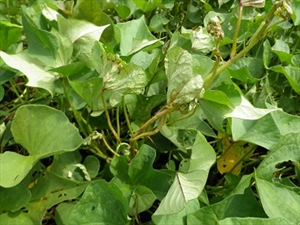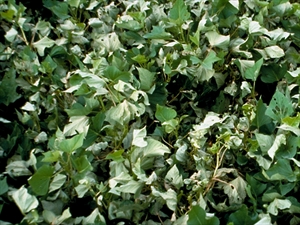Sweetpotato scab
Pacific Pests, Pathogens, Weeds & Pesticides - Online edition
Pacific Pests, Pathogens, Weeds & Pesticides
Sweetpotato scab (013)
Elsinoe batatas, but sometimes known as Sphaceloma batatas (the asexual stage). Usually, only the asexual state is seen on the leaves.
Asia, Africa (restricted), North (Hawaii), South (Brazil) America, the Caribbean, Ocean. It is recorded from Australia, Cook Islands, Federated States of Micronesia, Fiji, French Polynesia, Guam, New Caledonia, Niue, Northern Mariana Islands, Palau, Papua New Guinea, Solomon Islands, Tonga, and Vanuatu.
It is known only from sweetpotato.
Young leaves are infected along the veins, and infections also occur on the leaf stalks and stems (Photos 1&2). As the leaves grow, the damage to the veins prevents expansion, and they twist, curl and tear. On older leaves, infections produce pinpoint spots between the veins, and the leaves are twisted to expose the under surfaces (Photo 3). In severe, but rare cases, shoot-tips are killed.
The fungus is taken to new gardens on planting material. As the cuttings grow, the fungus produces very small spores in the scabby areas. These spores are spread by rain-splash from plant to plant or in wind-driven rain to other gardens. They germinate in water on the surface of the leaf and stem, penetrate, and cause the spots and scabby areas. Soon after infection, more spores are produced.
It is possible that the fungus survives in crop debris, but this is not important unless crops are planted one after the other on the same land. Most spread is from using infected vines.
A fungus causes the damage. Both Fiji and Tonga have recorded epidemics of the disease. In Tonga, in the 1980s, farmers stopped growing most varieties, until new varieties were bred using seed from Solomon Islands. Damage to the young shoots can slow early growth and reduce yields. In Papua New Guinea highlands, comparisons between healthy and diseased plants, showed a 60% difference in the yield of storage roots.
Look for the brown scabby marks on the leaf veins, stalks and stems. Look for torn, cup-shaped leaves and twisted stems.
BIOSECURITY
The unrestricted movement of plant propagating material (cuttings, shoots and storage roots) has the potential of further spreading Alternaria blight. Many countries in Africa and South America are yet free from the disease. The most likely pathway of entry is associated with unofficial transfers. For those that are officially sanctioned, follow the advice given in FAO/IBPGR Technical Guidelines for the Safe Movement of Sweet Potato Germplasm (http://www.bioversityinternational.org/e-library/publications/detail/sweet-potato/).
CULTURAL CONTROL
There is probably little that farmers can do to control this disease using cultural methods, other than the choice of variety. If the disease is severe in the crop, it might be best not to replant on the same land, but it is doubtful that it will make any difference. This is because the disease is spread from crop to crop in already infected planting material, and also from spores in wind-driven rain.
If growers want to grow susceptible varieties, because of their taste and/or high market value, for instance, then they should do the following:
Before planting:
- Produce disease-free planting material:
- Make a nursery on a raised bed, shaded by coconut leaves, and plant washed sweet potato roots, leaving a small gap (1-2 cm) between each root.
- Cut vines 30 cm long from the roots as they sprout, checking each one to ensure that it is free from scab disease. If scab is present, discard the vine.
- Plant vines in new gardens, where sweet potato has not been grown for 1-2 years, and as far from existing plantings as possible.
During growth:
- Delay infection by encouraging vigorous early growth: weed to reduce competition, supply adequate nutrition to promote rapid storage root development and early harvest.
After harvest:
- Collect the old vines and burn or bury them.
RESISTANT VARIETIES
This is the most important method of control. Varieties differ in their susceptibility to the disease. Some are tolerant. These should be selected and grown in preference to those that are susceptible. It is for this reason that scab is not usually a problem in Pacific island countries. Avoid those varieties that show severe symptoms.
CHEMICAL CONTROL
Scientists have used fungicides to control the disease in trials in Tonga and Papua New Guinea; however, they should not be needed if tolerant varieties are grown. However, commercial farmers might want to use fungicides to grow a susceptible variety for the market. The recommendations are to:
- Dip the cuttings for 15 minutes in mancozeb before planting.
- Spay with mancozeb at the first sign of symptoms.
- Repeat spraying at 14-day intervals, depending on the weather, until 1-2 months before harvest.
____________________
When using a pesticide, always wear protective clothing and follow the instructions on the product label, such as dosage, timing of application, and pre-harvest interval. Recommendations will vary with the crop and system of cultivation. Expert advice on the most appropriate pesticide to use should always be sought from local agricultural authorities.
AUTHORS Helen Tsatsia & Grahame Jackson
Information from Jackson G, McKenzie E (1991) Pest Advisory Leaflet 24. South Pacific Commission, Noumea, New Caledonia. (https://lrd.spc.int/component/docman/cat_view/137-all/128-plant-health-/276-pest-advisory-leaflets?start=40); and from Ekman J, Lovatt J (2015) Pests, Diseases and Disorders of Sweetpotato: A Field Identification Guide. (https://www.soilwealth.com.au/imagesDB/news/Sweet-Potato-Pest-and-Disease-Guide.pdf). Photo 2 John Bokosou, NARI, Papua New Guinea.
Produced with support from the Australian Centre for International Agricultural Research under project PC/2010/090: Strengthening integrated crop management research in the Pacific Islands in support of sustainable intensification of high-value crop production, implemented by the University of Queensland and the Secretariat of the Pacific Community.






